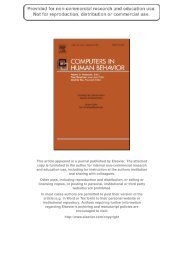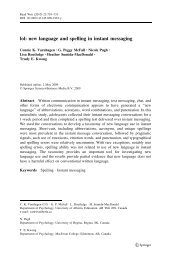Six Models for the Internet + Politics
You also want an ePaper? Increase the reach of your titles
YUMPU automatically turns print PDFs into web optimized ePapers that Google loves.
Archon Fung, Hollie Russon Gilman, and Jennifer Shkabatur 43<br />
to be an effective method of monitoring made possible by ICTs that complements<br />
more traditional strategies. So, we can expect to see more crowd-sourced<br />
monitoring in <strong>the</strong> future.<br />
In <strong>the</strong> field research that in<strong>for</strong>ms this article, we examined four projects that<br />
employed crowdsourcing methods in very different ways: Ushahidi, Uchaguzi,<br />
Kiirti, and Reclamos.<br />
Ushahidi, perhaps <strong>the</strong> most celebrated ICT plat<strong>for</strong>m in <strong>the</strong> political accountability<br />
domain, is a prime example of political crowdsourcing. Ushahidi (meaning<br />
“testimony” in Swahili) was initially launched by political bloggers to map<br />
incidents of post-election violence in Kenya in <strong>the</strong> beginning of 2008. It aggregated<br />
reports that citizens submitted via <strong>the</strong> web or mobile phones regarding<br />
violations of human rights, and tagged <strong>the</strong>m on a publicly available Google map,<br />
according to predefined categories.<br />
The success of <strong>the</strong> original Ushahidi plat<strong>for</strong>m 21 was unprecedented compared<br />
with o<strong>the</strong>r accountability ICT plat<strong>for</strong>ms. It attracted more than 45,000 users in<br />
Kenya alone and exposed events that Kenyan mainstream media was reluctant<br />
to report and international media was not fully aware of. Fur<strong>the</strong>r, Kenyan<br />
Ushahidi served as a catalyst <strong>for</strong> dozens of similar experiments around <strong>the</strong><br />
world, in particular in <strong>the</strong> field of election monitoring (Liberia (2011), Brazil<br />
(2010), India (2010), Mexico (2009), Philippines (2009) and o<strong>the</strong>r countries).<br />
While all <strong>the</strong>se experiments were designed according to <strong>the</strong> original Ushahidi<br />
plat<strong>for</strong>m, <strong>the</strong> model underwent substantial modifications. In order to<br />
streng<strong>the</strong>n <strong>the</strong> credibility and accuracy of <strong>the</strong> original Ushahidi model, <strong>the</strong><br />
operators of each deployment attempt to verify reports by calling <strong>the</strong> reporter<br />
back or by relying on newly developed verification technologies (such as Swift-<br />
River). In addition to tagging reports that are sent by <strong>the</strong> “crowd,” <strong>the</strong> operators<br />
are also responsible <strong>for</strong> crawling <strong>the</strong> web and aggregating reports from a variety<br />
of media sources.<br />
Despite its global acclaim and numerous replications, <strong>the</strong> Ushahidi model has<br />
failed to translate its initial appeal into ei<strong>the</strong>r mass participation or tangible<br />
increases in <strong>the</strong> integrity of elections. 22 The rate of participation on plat<strong>for</strong>ms<br />
that are based on <strong>the</strong> original Ushahidi plat<strong>for</strong>m remained low and even reports<br />
that appeared on <strong>the</strong> plat<strong>for</strong>m seemed rarely to result in tangible actions in <strong>the</strong><br />
field.<br />
Against <strong>the</strong> background of this sobering reality, Uchaguzi 23 —yet ano<strong>the</strong>r<br />
Ushahidi deployment—was redesigned to monitor <strong>the</strong> Kenyan constitutional<br />
referendum in August 2010. While Uchaguzi (meaning “testimony”) conceptually<br />
inherited Ushahidi in <strong>the</strong> domain of Kenyan election monitoring, it took a<br />
fundamentally different approach. In a sharp deviation from <strong>the</strong> diffuse and<br />
little-structured operational mode of Ushahidi, Uchaguzi was rooted in <strong>the</strong> collaboration<br />
of several NGOs. Each was responsible <strong>for</strong> a specific part of <strong>the</strong><br />
monitoring ef<strong>for</strong>t. Instead of relying on a political genie that would leave <strong>the</strong><br />
bottle and generate new and unprecedented dynamics in Kenyan politics,<br />
Uchaguzi developed partnerships with election-monitoring NGOs and <strong>the</strong> governmental<br />
body responsible <strong>for</strong> <strong>the</strong> constitutional referendum—<strong>the</strong> Interim<br />
Independent Electoral Commission (IIEC)—as <strong>the</strong> main users of <strong>the</strong> in<strong>for</strong>mation<br />
ga<strong>the</strong>red through <strong>the</strong> plat<strong>for</strong>m. To <strong>the</strong> extent that those who implemented<br />
<strong>the</strong> original Ushahidi possessed a <strong>the</strong>ory of change, it implicitly<br />
supposed that <strong>the</strong> plat<strong>for</strong>m would constitute new political <strong>for</strong>ces and actors—<br />
crowds to report election violence and o<strong>the</strong>r violations and <strong>the</strong>n to hold <strong>the</strong><br />
violators accountable. Uchaguzi, which is Ushahidi 2.0, repudiates this revolu-<br />
21 http://www.ushahidi.com/.<br />
22 Peixoto (2012).<br />
23 http://uchaguzi.co.ke/.
















